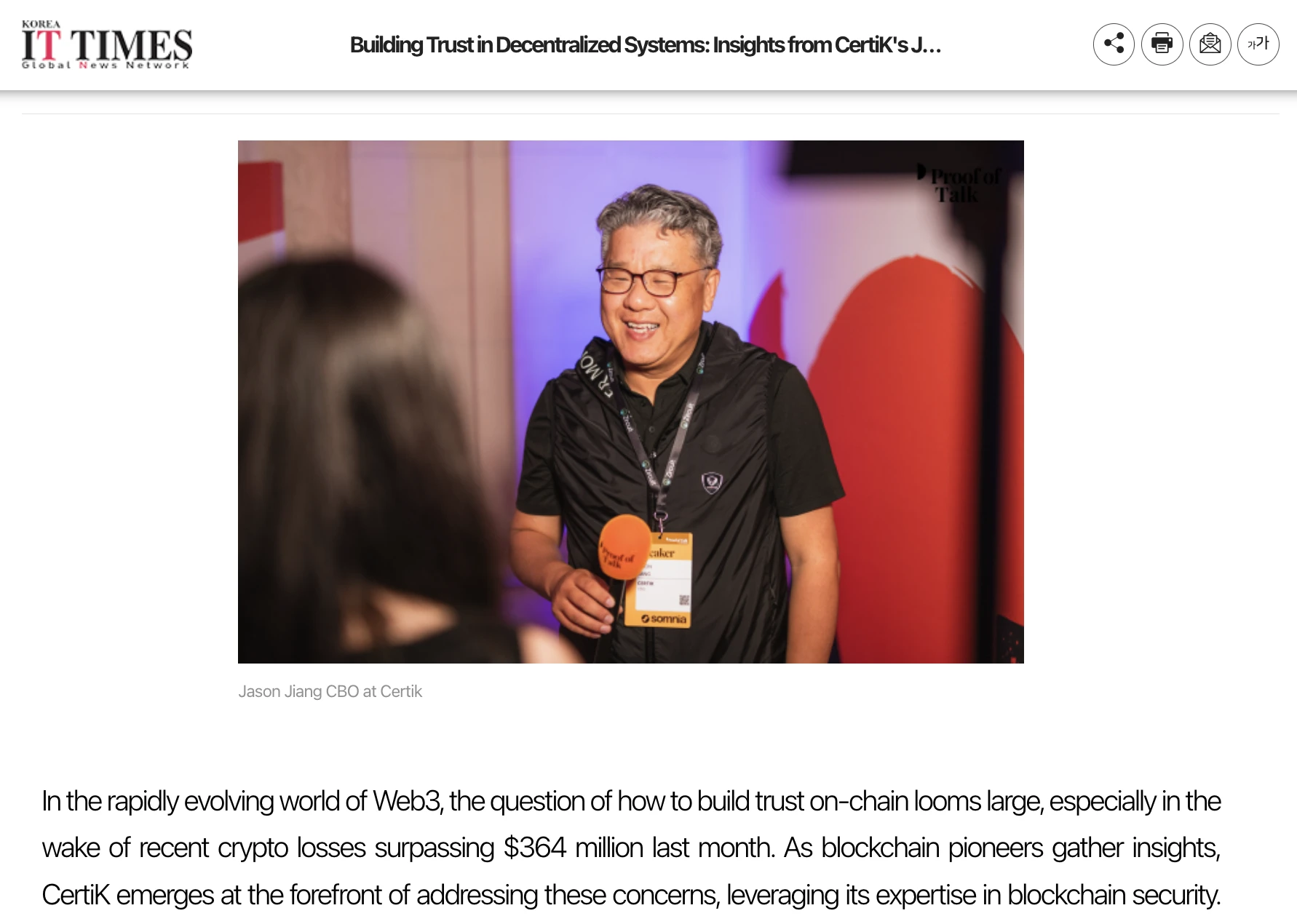On June 19, Korea IT Times, a well-known Korean technology media, focused on the keynote speech of Jason Jiang, CertiKs Chief Business Officer, at the Proof of Talk 2025 conference, focusing on his systematic insights on building trust in Web3. Jason Jiang pointed out that static audits are indispensable, but far from enough to support the trust system required by Web3. Audited is by no means the same as secure, and true trust should be built on a comprehensive mechanism of code, behavior, culture, and compliance.

Jason Jiang said that CertiK is promoting a dynamic security as a service model, and continues to promote the construction of security infrastructure through on-chain audit certification, real-time security monitoring and risk scoring, AI-assisted auditing, etc. Technology products represented by Skynet are reshaping the industrys standards for trust.
Korea IT Times believes that this dynamic model is the key to winning the trust of users and the industry. CertiKs forward-looking strategy shows how to effectively address Web3 security challenges through proactive and adaptable security solutions and drive the industry towards a secure and trusted future.
The following is the full report:
Rebuilding Trust in a Decentralized System: CertiK Chief Business Officer Jason Jiang’s Insights at Proof of Talk 2025
In the ever-changing world of Web3, how to build trust on-chain is becoming a core issue. Especially in the context of the crypto industry losing more than $364 million last month, the trust issue is even more urgent. As the blockchain industry continues to explore new paths, CertiK is at the forefront of addressing these challenges with its expertise in blockchain security. At the Proof of Talk 2025 conference, Jason Jiang, CertiK’s Chief Business Officer, delivered a keynote speech, raising a series of thought-provoking views on the core issue of “How to build trust in Web3”.
Jason Jiang first elaborated on the inherent challenges of Web3 security and the limitations of traditional static auditing. He emphasized: As CertiK has always advocated, static code verification, no matter how high the standard is, is only one part of the security model. It is necessary, but far from enough to build real trust. Many risks are exposed only after the audit. His words reveal the growing complexity of the current blockchain security system: upgradeable contracts, deviations from governance mechanisms, external account control and other factors will all lead to new security risks. As he said: Audited is by no means the same as secure.
He believes that the speed of change in the Web3 industry is unprecedented. In the crypto world, one year of change is comparable to eight years in the traditional industry. He pointed out that true trust is not only based on the accumulation of time, but also requires systematic mechanism guarantees. Trust in Web3 is not just the code itself, but a combination of code, behavior, culture and compliance. He particularly mentioned the importance of the bug bounty program, and believed that project parties should invest resources to establish a transparent accountability mechanism, and publish detailed review reports in a timely manner after security incidents.
CertiK is driving a paradigm shift in trust mechanisms. Jason Jiang made it clear in his speech that CertiK is shifting security from a static audit as security model to a dynamic security as a service model. He said: We are driving the transition from traditional static audits to dynamic security operations. This includes promoting on-chain audit certification, introducing real-time security monitoring and risk scoring, continuous verification mechanisms, and the technical evolution of AI-assisted audits.
This concept is implemented through real-time monitoring and risk scoring tools such as Skynet, as well as AI-assisted analysis products, marking CertiKs continued investment in building a holistic security infrastructure. This security architecture not only provides solid technical support for Web3 projects, but is also reshaping the industrys standard for trust.
Jason Jiangs sharing shows that to establish true trust in a decentralized system, a comprehensive strategy must be adopted: continuous security assessments, transparent codes of conduct, and a culture of continuous improvement. This dynamic approach is the key to winning the trust of users and the industry, and paving the way for building a safer and more trusted Web3 ecosystem. As the industry enters a new stage, CertiKs forward-looking strategy demonstrates how to effectively address Web3 security challenges through proactive and adaptable security solutions, driving the industry towards a more secure and trusted future.










